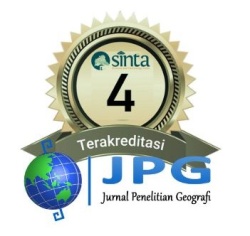Analysis of Vulnerability to Earthquake Hazard in Bantul Regency, Yogyakarta
Abstract
This study aims to assess the level of earthquake vulnerability in Bantul Regency, Yogyakarta based on three main dimensions: physical, social and economic. The method used was quantitative analysis with a scoring and overlay approach, using secondary data from the Central Bureau of Statistics. The results show that Bantul Regency has a high vulnerability to earthquake disasters. High vulnerability results in physical and economic parameters are indicated by vulnerable infrastructure and dependence on economic sectors that are easily affected by earthquakes. Social vulnerability is at a moderate level, although factors such as population density and vulnerable groups still require special attention. The research identifies the need for community capacity building and earthquake-resistant infrastructure to minimize the impact of future earthquakes, as well as inclusive and community-based mitigation policies to increase resilience to earthquake disasters.
Keywords: Vulnerability;Earthquakes;Scoring
Full Text:
PDFReferences
Ashadi, A. L., Harmoko, U., Yuliyanto, G., & Kaka, S. I. (2015). Probabilistic seismic-hazard analysis for central java province, indonesia. Bulletin of the Seismological Society of America, 105(3), 1711–1720. https://doi.org/10.1785/0120140277
Aulady, M. F. N., & Fujimi, T. (2019). Policy Implication for Economic Losses Reduction Due to Earthquake Disaster in Bantul City, Indonesia. IOP Conference Series: Materials Science and Engineering, 462(1). https://doi.org/10.1088/1757-899X/462/1/012051
Bahadori, H., Hasheminezhad, A., & Karimi, A. (2017). Development of an integrated model for seismic vulnerability assessment of residential buildings: Application to Mahabad City, Iran. Journal of Building Engineering, 12, 118–131. https://doi.org/10.1016/j.jobe.2017.05.014
BAPPENAS. (2016). REPORT ON THE YOGYAKARTA-CENTRAL JAVA EARTHQUAKE DISASTER.
Bawono, A. S. (2016). Studi Kerentanan Bangunan Akibat Gempa : Studi Kasus Perumahan Di Bantu. JURNAL ILMIAH SEMESTA TEKNIKA, 19(1), 90–97.
BPS. (2022). KABUPATEN BANTUL DALAM ANGKA 2022.
BPS Kabupaten Bantul. (2019). Statistics of Bantul Regency.
BPS Kabupaten Bantul. (2023). Produk Domestik Regional Bruto Kabupaten Bantul Menurut Lapangan Usaha 2019-2023.
Briguglio, L. (2004). ECONOMIC VULNERABILITY AND RESILIENCE: CONCEPTS AND MEASUREMENTS. Conceptual and Methodological Issues. www.un.org/documents/ecosoc/docs/1998/el998-5.htm
Dwi Pratama, A. R., Soetjipto, J. W., & Krisnamurti, K. (2021). Evaluation of Building Vulnerability to Earthquake Using Rapid Visual Screening (RVS) Method. Jurnal Teknik Sipil Dan Perencanaan, 23(2), 114–124. https://doi.org/10.15294/jtsp.v23i2.31399
Faridzi, A. S., Shafa Azizah, F., Mustafa, F., Nindya Putri, A., Ramadhika, G., Rizky Aditya, F., Sherli Fadilah, R., Habibi, Y., Sutrisno, M., Dewi Risanty, R., & Rosanti, N. (2024). PENGOLAHAN DATA : Pemahaman Gempa Bumi Di Indonesia Melalui Pendekatan Data Mining. Jurnal Pengabdian Kolaborasi Dan Inovasi IPTEKS, 1, 262–270.
Fayaz, M., Romshoo, S. A., Rashid, I., & Chandra, R. (2023). Earthquake vulnerability assessment of the built environment in the city of Srinagar, Kashmir Himalaya, using a geographic information system. Natural Hazards and Earth System Sciences, 23(4), 1593–1611.https://doi.org/10.5194/nhess-23-1593-2023
French, S. P. (2016). CONNECTING PHYSICAL DAMAGE TO SOCIAL AND ECONOMIC IMPACTS. 17th U.S-Japan-New Zealand Workshop on the Improvement of Structural Engineering and Resilience.
GEM. (2020). Launch of GEM Global Social Vulnerability map.
Global Facility for Disaster Reduction and Recovery. (2020). Gender Equality and Women’s Empowerment in Disaster Recovery.
He, D., Miao, P., & Qureshi, N. A. (2022). Can industrial diversification help strengthen regional economic resilience? Frontiers in Environmental Science, 10. https://doi.org/10.3389/fenvs.2022.987396
IPES Food. (2024). Land Squeeze: What is driving unprecedented pressures on farmland and what can be done to achieve equitable access to land? www.heartsnminds.eu
Jena, R., & Pradhan, B. (2020). Integrated ANN-cross-validation and AHP-TOPSIS model to improve earthquake risk assessment. International Journal of Disaster Risk Reduction, 50. https://doi.org/10.1016/j.ijdrr.2020.101723
Joakim, E. (2012). Reducing Vulnerability and Building Resilience in the Post-Disaster Context: A Case Study of the 2006 Yogyakarta Earthquake Recovery Effort. Jurnal Sains Dan Teknologi Lingkungan, 4, 1–14.
Koulali, A., McClusky, S., Susilo, S., Leonard, Y., Cummins, P., Tregoning, P., Meilano, I., Efendi, J., & Wijanarto, A. B. (2017). The kinematics of crustal deformation in Java from GPS observations: Implications for fault slip partitioning. Earth and Planetary Science Letters, 458, 69–79. https://doi.org/10.1016/j.epsl.2016.10.039
Lin, B. C., & Lee, C. H. (2024). Assessing the efficacy of adaptive capacity-building strategies in earthquake-prone communities. Geomatics, Natural Hazards and Risk, 15(1). https://doi.org/10.1080/19475705.2024.2380908
Mantika, N. J., Hidayati. Solikhah Retno, & Fathurrohmah, S. (2020). IDENTIFIKASI TINGKAT KERENTANAN BENCANA DI KABUPATEN GUNUNGKIDUL. MATRA, 1(1), 59–70.
Marlina, H., Ruslanjari, D., & Hakim, I. B. A. (2024). Disaster risk financing and insurance for earthquake-prone state buildings in Indonesia. Jamba: Journal of Disaster Risk Studies, 16(1). https://doi.org/10.4102/JAMBA.V16I1.1597
Murtakhamah, T. (2013). PENTINGNYA PENGARUSUTAMAAN GENDER DALAM PROGRAM PENGURANGAN RISIKO BENCANA. Jurnal Ilmu Kesejahteraan Sosial, 2(1).
Nakamura, Y. (2000). CLEAR IDENTIFICATION OF FUNDAMENTAL IDEA OF NAKAMURA’S TECHNIQUE AND ITS APPLICATIONS. System and Data Research Co. Ltd.
Nazmfar, H., Saredeh, A., Eshgi, A., & Feizizadeh, B. (2019). Vulnerability evaluation of urban buildings to various earthquake intensities: a case study of the municipal zone 9 of Tehran. Human and Ecological Risk Assessment, 25(1–2), 455–474. https://doi.org/10.1080/10807039.2018.1556086
NERA. (2014). Framework for Social Vulnerability and Impact Quantification from Earthquakes.
Neumayer, E., & Plümper, T. (2007). The gendered nature of natural disasters: The impact of catastrophic events on the gender gap in life Expectancy, 1981-2002. Annals of the Association of American Geographers, 97(3), 551–566. https://doi.org/10.1111/j.1467-8306.2007.00563.x
Nurhaci, D. S., Setianto, A., & Wilopo, W. (2024). Analysis and Evaluation of Earthquake Hazard Zones Based on Spatial Models for Regency Regional Development Bantul. IOP Conference Series: Earth and Environmental Science, 1373(1), 012014. https://doi.org/10.1088/1755-1315/1373/1/012014
Nwafor, A., & Ngoga, T. H. (2020). Are agriculture systems well prepared to withstand high impact shocks such as the COVID-19 pandemic, and, faced with such shocks, are they resilient? https://www.worldbank.org/en/topic/agriculture/brief/food-security-and-covid-19
Pahleviannur, M. R., Ayuni, I. K., Widiastuti, A. S., Umaroh, R., Aisyah, H. R., Afiyah, Z., Azzahra, I., Chairani, M. S., Dhafita, N. A., Rohmah, N. L., Sudrajat, S., Mardiatno, D., Rachmawati, R., & Rahardjo, N. (2023). Kerentanan Sosial Ekonomi terhadap Bencana Banjir di Hilir DAS Citanduy Bagian Barat Kabupaten Pangandaran Jawa Barat. Media Komunikasi Geografi, 24(2), 189–205. https://doi.org/10.23887/mkg.v24i2.66370
Perka BNPB 2012 (2012).
Raduszynski, T., & Numada, M. (2023). Measure and spatial identification of social vulnerability, exposure and risk to natural hazards in Japan using open data. Scientific Reports, 13(1). https://doi.org/10.1038/s41598-023-27831-w
Rahmaningtyas, N., Jawoto, D., & Setyono, S. (2015). Tingkat Kerentanan Sosial Wilayah Kabupaten Wonogiri. In Teknik PWK (Vol. 4, Issue 4).
Saputra, A., Rahardianto, T., Revindo, M. D., Delikostidis, I., Hadmoko, D. S., Sartohadi, J., & Gomez, C. (2017). Seismic vulnerability assessment of residential buildings using logistic regression and geographic information system (GIS) in Pleret Sub District (Yogyakarta, Indonesia). Geoenvironmental Disasters, 4(1). https://doi.org/10.1186/s40677-017-0075-z
Scapini, V. (2020). Disaster, infrastructure damage, and health. International Journal of Safety and Security Engineering, 10(2), 219–225. https://doi.org/10.18280/ijsse.100208
Shadmaan, Md. S., & Popy, S. (2023). An assessment of earthquake vulnerability by multi-criteria decision-making method. Geohazard Mechanics, 1(1), 94–102. https://doi.org/10.1016/j.ghm.2022.11.002
Sipayung, W. Y., Maryani, E., Somantri, L., Setiawan, I., & Sitepu, S. (2023). ANALISIS TINGKAT KERENTANAN BENCANA (Studi Kasus: Kawasan Cagar Budaya Candi Muara Jambi). Majalah Ilmiah Methoda, 13(1), 49–60. https://doi.org/https://doi.org/10.46880/methoda.Vol13No1.pp49-60
Stein, S., & Wysession, M. (2003). An Introduction to Seismology, Earthquakes, and Earth Structure . Physics Today, 56(10), 66–67. https://doi.org/10.1063/1.1629009
Sukadi, E. (2022). Does Economic Diversification Foster Resilience to Crises? Empirical Investigation. https://ssrn.com/abstract=4273418
Sukmawati, A. M., & Utomo, P. (2022). KERENTANAN SOSIAL TERHADAP BENCANA DI KABUPATEN BANTUL PROVINSI D.I. YOGYAKARTA. Nusantara Hasana Journal, 2(2), 418–429.
Suprapto, F. A., Juanda, B., Rustiadi, E., & Munibah, K. (2022). Study of Disaster Susceptibility and Economic Vulnerability to Strengthen Disaster Risk Reduction Instruments in Batu City, Indonesia. Land, 11(11). https://doi.org/10.3390/land11112041
Suryanto, S., & Kuncoro, M. (2012). Risk Perception and Economic Value Of Disaster Mitigation Case of Bantul Post Earthquake May 2006. The South East Asian Journal of Management, 6(2). https://doi.org/10.21002/seam.v6i2.1319
Syafitri, Y., & Didik, L. A. (2019). ANALISIS PERGESERAN LEMPENG BUMI YANG MENINGKATKAN POTENSI TERJADINYA GEMPA BUMI DI PULAU LOMBOK. http://jurnalkonstan.ac.id/index.php/jurnal
Tsuji, T., Yamamoto, K., Matsuoka, T., Yamada, Y., Onishi, K., Bahar, A., Meilano, I., & Abidin, H. Z. (2009). Earthquake fault of the 26 May 2006 Yogyakarta earthquake observed by SAR interferometry. In Earth Planets Space (Vol. 61).
Zhang, J., Bai, Z., Ma, J., Qu, S., Tian, J., Wang, S., & Zhang, R. (2025). Predictive analysis of seismic damage to buildings near-surface faults under the influence of multiple factors. PLoS ONE, 20(5 May). https://doi.org/10.1371/journal.pone.0320930
Refbacks
- There are currently no refbacks.
INDEX JOURNAL

















